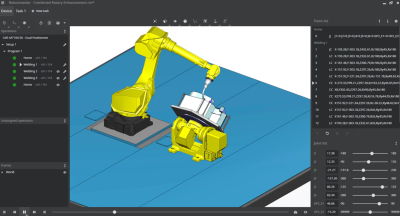
Hypertherm, a U.S. based manufacturer of industrial cutting systems and software, today announced the release of Robotmaster Version 7.4. This newly released offline robot programming software version contains several enhancements designed to further simplify robotic programming, including:
- Major enhancements to Remote Tool Center Point (RTCP) that allow for an improved end user experience and exploit the full capabilities of any robotic cell.
- Additions to the surface paths with added strategies and advanced tools for applications such as polishing, grinding, deburring and more. The surface paths are designed to tie-in perfectly with the enhancements to RTCP or traditional configurations for robotic finishing.
- Faster processing times when saving, loading, and calculating jobs, plus improved real time feedback during simulation for faster part programming times.
- Enhancement to the Robotmaster Interactive Simulation Environment (RISE), delivering a more realistic simulation for external axes, along with tools to better control motion between the robot and external axes.
“With Robotmaster V7.4 we’ve responded to our customer base with features and enhancements that we believe take a big step forward,” explained Garen Cakmak, leader of Hypertherm’s Robotic Software team. “Take the RTCP improvements as an example. These will allow users to realize more value from their robotic cell investment.”
Building upon the redesigned V7 architecture, first introduced in 2018, Robotmaster uses integrated CAD/CAM functionality to make robotic programming easy and intuitive for everyone, even first-time users. The software is used by a wide range of industries to program robots for tasks that include surfacing, 3D milling, additive manufacturing, welding, painting, and more.
Hypertherm engineers and manufactures industrial cutting products used by companies around the world to build ships, airplanes, and railcars, construct steel buildings, manufacture heavy equipment, and more. Its products include cutting systems, CNCs, and software trusted for performance and reliability that result in increased productivity and profitability for hundreds of thousands of businesses. Founded in 1968 and based in New Hampshire, Hypertherm is a 100 percent Associate owned company, employing more than 1,800 Associates, with operations and partner representation worldwide. Learn more at www.hypertherm.com.
Contact Details
Related Glossary Terms
- gang cutting ( milling)
gang cutting ( milling)
Machining with several cutters mounted on a single arbor, generally for simultaneous cutting.
- grinding
grinding
Machining operation in which material is removed from the workpiece by a powered abrasive wheel, stone, belt, paste, sheet, compound, slurry, etc. Takes various forms: surface grinding (creates flat and/or squared surfaces); cylindrical grinding (for external cylindrical and tapered shapes, fillets, undercuts, etc.); centerless grinding; chamfering; thread and form grinding; tool and cutter grinding; offhand grinding; lapping and polishing (grinding with extremely fine grits to create ultrasmooth surfaces); honing; and disc grinding.
- milling
milling
Machining operation in which metal or other material is removed by applying power to a rotating cutter. In vertical milling, the cutting tool is mounted vertically on the spindle. In horizontal milling, the cutting tool is mounted horizontally, either directly on the spindle or on an arbor. Horizontal milling is further broken down into conventional milling, where the cutter rotates opposite the direction of feed, or “up” into the workpiece; and climb milling, where the cutter rotates in the direction of feed, or “down” into the workpiece. Milling operations include plane or surface milling, endmilling, facemilling, angle milling, form milling and profiling.
- polishing
polishing
Abrasive process that improves surface finish and blends contours. Abrasive particles attached to a flexible backing abrade the workpiece.

